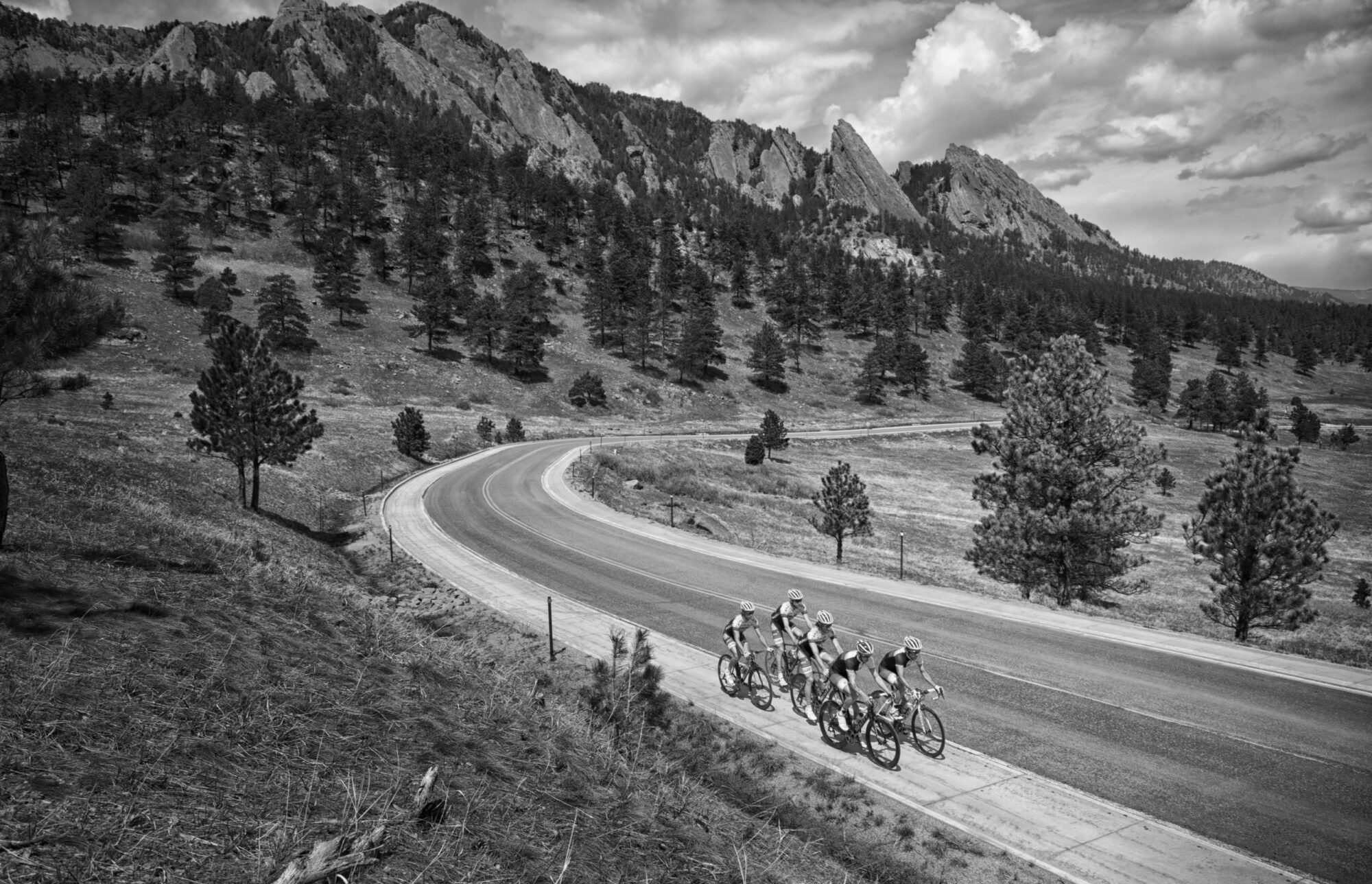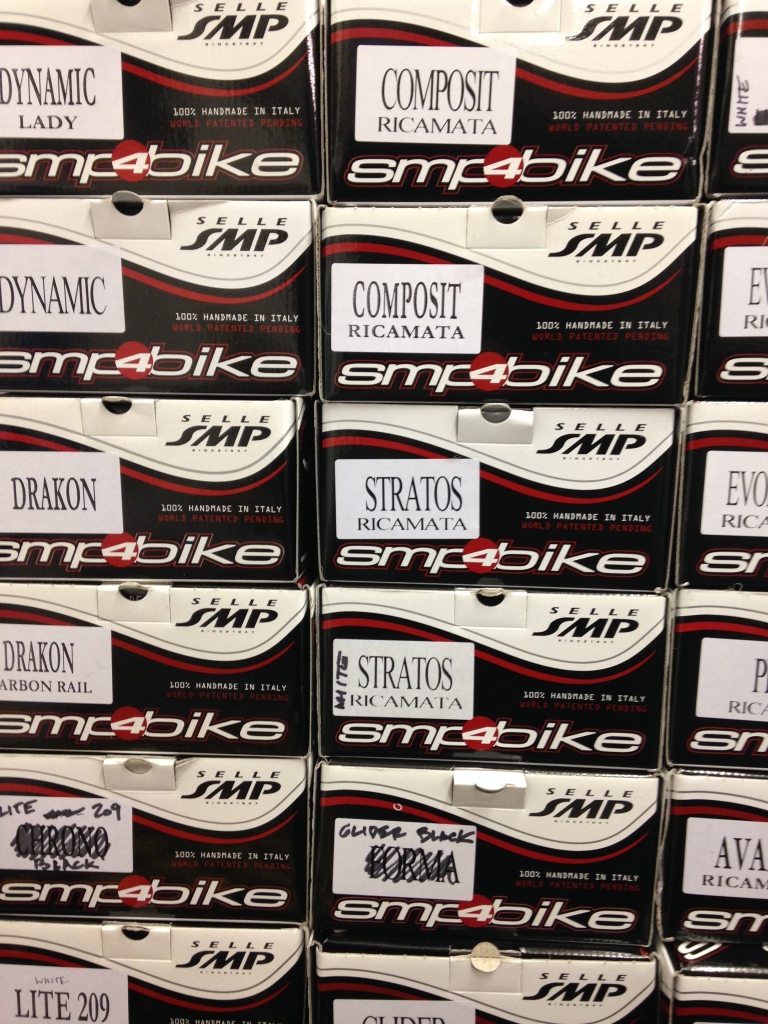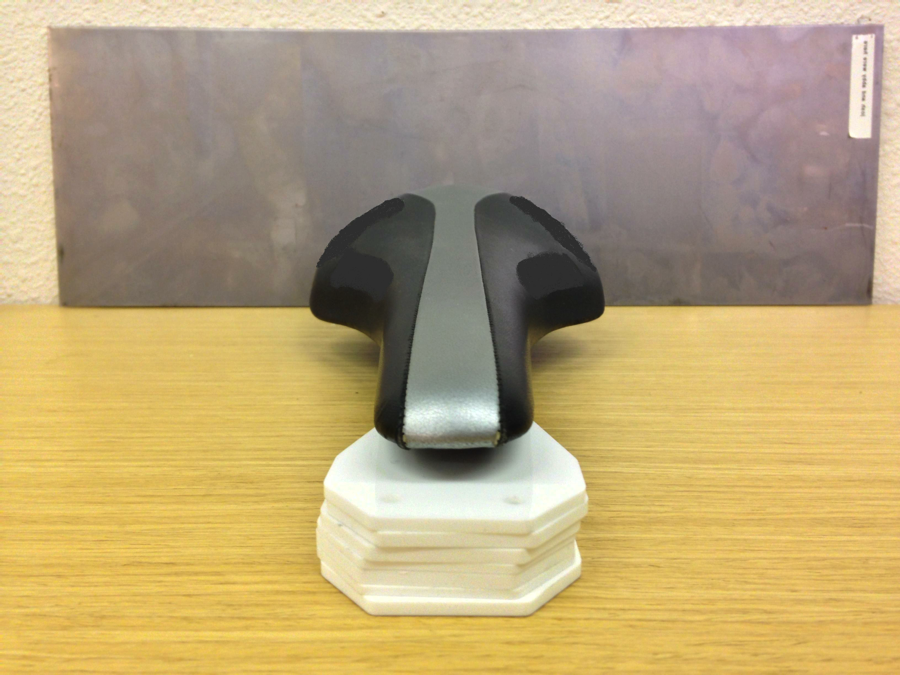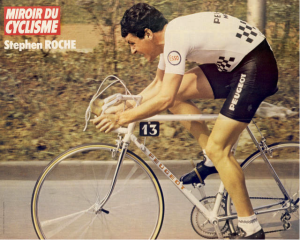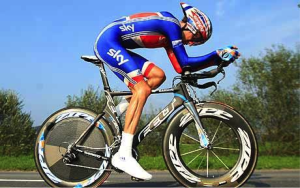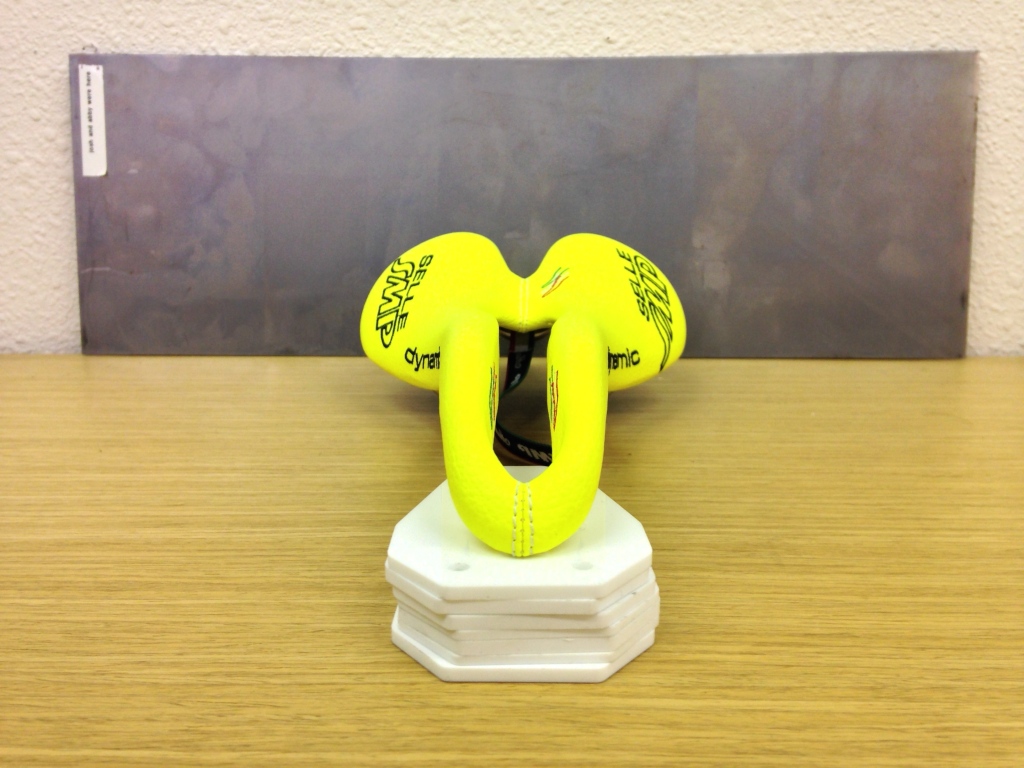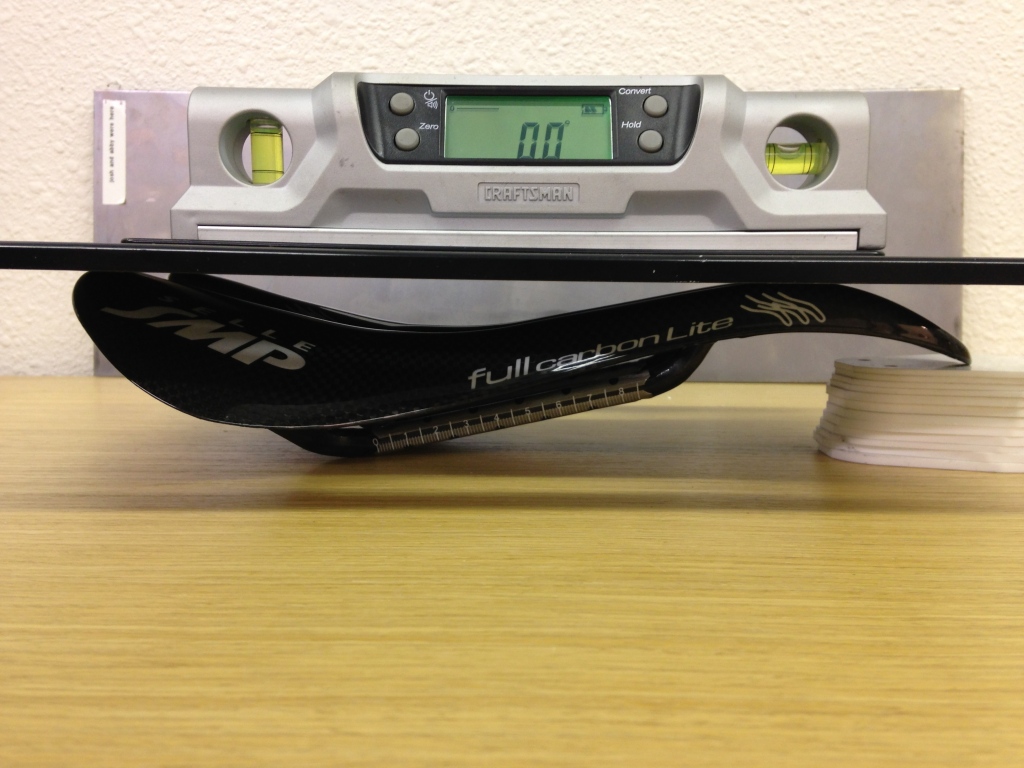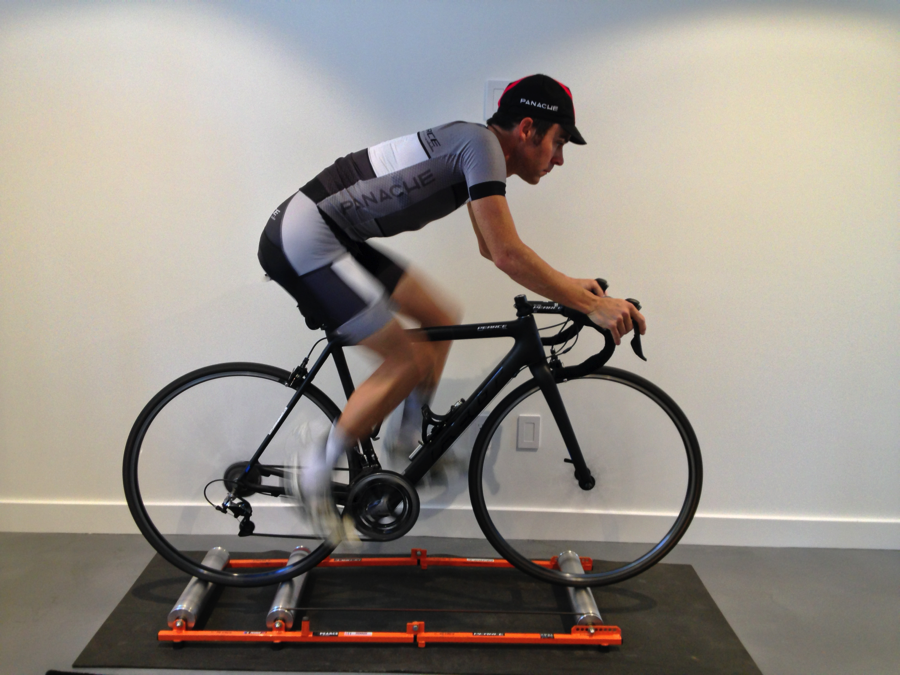 Changing saddles can be a daunting undertaking for any cyclist. Riders frequently use the same saddle for years simply because they find one which is unobjectionable, but far from perfect. The logistical challenges of finding saddles to try without financial investment, and the set up of a new saddle during training and/or competition season is enough to keep riders on the same model for consecutive seasons even when it may not be the ideal choice. The athlete concedes to settling for a saddle that is not a hatchet or a bed of nails, and frequently concerns about optimal support or function on the bike are far from being considered as selection parameters.
Changing saddles can be a daunting undertaking for any cyclist. Riders frequently use the same saddle for years simply because they find one which is unobjectionable, but far from perfect. The logistical challenges of finding saddles to try without financial investment, and the set up of a new saddle during training and/or competition season is enough to keep riders on the same model for consecutive seasons even when it may not be the ideal choice. The athlete concedes to settling for a saddle that is not a hatchet or a bed of nails, and frequently concerns about optimal support or function on the bike are far from being considered as selection parameters.
As a competitor, fitter and coach, I have ridden and raced bicycles for over 25 years and have experienced many different bicycle saddles in that time. In my opinion, SMP makes the best saddle on the market right now, hands down. The next closest product on the market is the Specialized Romin (it is a distant second) and everything else is light years behind. Some modern saddles are completely antithetical to comfort and performance. I don’t claim to be familiar with every single saddle available for purchase at this moment, but this is what I can say about the rather large number I have seen in person.
There are some saddles on the market which are basically “lessor evolved” versions of SMP saddles. These are saddles with cutouts, but no curvature, or saddles which have cutouts but do not connect at the tip. In my experience, saddles that do not form a stable structure by connecting the two halves on both ends nearly always become warped under heavy use or over a long enough time line.
Many old saddles (even some still sold on the market today) are relics of ancient cycling culture and should be retired forever, along with down tube shifters, U- brakes and leather soled shoes. Fortunately, as an educated consumer, you can now make better choices, which will enable you to ride more comfortably, with more power, for longer than ever before on a bicycle.
There are several points listed below that highlight why I feel so strongly that SMP has made a superior product. Briefly, these are:
- A large central cutout allows anterior (forward) rotation of the pelvis without increasing pressure on the soft tissue (perineum).
- A curved shape when viewed from the side more closely matches the contours of the curved ischium (commonly the “sit bones”), which allows both superior distribution of pressure, and increased pelvic stability (both fore-aft and side to side).
- The superior support of the bony surfaces allows for less padding, which makes for a lighter more minimalist saddle, improved pelvic stability, and even improved riding technique.
The basic design of the SMP saddle line is to simply mirror the underside of the two inferior halves of the human pelvis (the ischium). SMP saddles are shaped to match the contour of the human pelvis more closely than traditional saddles. The benefit is that this shaping gives you better support; it allows for superior pelvic stability in all planes of movement. The tradeoff is that the saddle must be positioned more precisely. There is less room for error in saddle angle, setback, and height.
I make these statements in the context of human anatomy and function on the bike. Many saddles on the market today do not allow a rider to achieve an optimum position at all, and some only while making serious compromises in health and /or performance. One of my core beliefs as a bike fitter is the basis for these statements: the more stable and supported the pelvis, the more functional a cyclist will be. This means more endurance, speed and power. Not every rider or fitter will agree with or even understand this statement but I am fully convinced it is the truth.
Point number one: The Cutout
Every bicycle saddle, regardless if the rider is short, tall, lean, fat, has a huge butt or no hips, is a male or female, should have a cutout. The soft tissue (perineum, or colloquially the grundel, taint or gooch) must often support the weight of the trunk, arms and head while riding a bicycle on a traditionally shaped saddle. Cycling is an artificial construct and when the weight of the torso is supported this way, the result is often pain, numbness, discomfort, saddle sores, and instability. Fortunately, we have made great progress in this area through minor innovations in the last 10-15 years and it is possible to successfully support the weight of a human trunk in a manner that does not smash your sex organs and urinary tract while riding a bicycle: by creating a saddle which is designed for most of the weight to be borne by the bony structure of the underside of the pelvis (namely, the ischium). The invention of the cutout saddle is as big of a leap in technology as when shifters were moved from the down tube to a combination shifter/ brake lever. Anyone riding an “old school” saddle is stuck in the Flintstone era. Old school saddles, which I refer to as “flat/dome” saddles, are the opposite design of a SMP with a flat profile (as viewed from the side) or a dome shaped profile (when viewed from the front).
A “flat/dome” saddle example.
Why is a cutout so essential? First, in order for a rider to apply maximum power to the saddle, he or she must be able to use the largest muscle in their body to effectively extend the hip: the gluteus maximus. In order to activate the glute effectively, an athlete must be able to at least keep the pelvis in line with the spine during forward rotation. This means the pelvis will be tilted forward (anterior) relative to the horizon as the athlete sits on the bike in moderately aggressive position (or more aggressive). The forward bend happens at the hip, not in the lumbar spine. The glute cannot be used effectively if the pelvis is rotated backwards (or tilted to the posterior) as a rider is sitting on the saddle. But, this is how many riders have sat on a bike for years, as this photo shows:
Notice the nearly vertical angle of the sacrum (the black part of the shorts).
Of course, it is possible to ride with a forward (or anterior) rotated pelvis in the modern era, on a “dome/flat” shaped saddle. There are riders who do it at the ProTour level today. One of the best examples of this is Bradley Wiggins:
Wiggins is going a better job of rotating his pelvis forward than Roche did, but at great expense to his soft tissue or perineum, and his lumber spine. I hypothesize that Wiggins could rotate substantially further if his saddle had an appropriate cutout.
Anterior rotation of the pelvis during hip extension is essential for proper muscle recruitment. As a simple experiment, try a standing back squat with an unweighted dowel, with your butt tucked under (sacrum vertical), as Stephen Roche is in the photo above. If you attempt a squat in a gym using this technique, not only would you most likely injure your back, as the lumbar spine would be supporting the weight, but you would also be unable to engage the gluteus maximus to drive the feet into the floor and lift the weight off the ground. The glutei maximi are the largest pair of muscles in the human body; we definitely want to take advantage of them when we pedal our bicycles.
Now try the same experiment, but this time use that “junk in your trunk” and stick your butt out, while flattening your lower (lumber spine). With your glutes engaged, it is possible to drive the heel into the floor, using both your glutes and quads to extend the hip as you thrust your torso upwards. When the pelvis is posteriorly rotated, function of the glutes is inhibited.
Many may think this discussion is absurd because Stephen Roche was a great professional rider, who won grand Tours, and therefore assume his choice of equipment was flawless and technique was perfect. Certainly, all the other riders who rode with rainbow shaped backs could not be doing it wrong as well; Kelly, Merckx, Hinault, etc. While Roche was certainly a great rider who won some of the worlds’ biggest races, who was one of the strongest riders of his generation, I argue that the technique he was using is by current standards outdated and archaic. Just as we now know it is not performance enhancing to eat steak the morning of a long road race, and that it is not advantageous to drink rum during snowy cold events, we know that in order to deliver optimal power to the pedals, the pelvis must be rotated forward. It is simply a matter of developing understanding of human function and improved positioning on the bike. Roche was not doing anything wrong; it is just that saddle technology has progressed to allow a superior method of sitting on a bicycle. There may be a better way yet again in another decade.
In my opinion, the invention of the cutout saddle was as big of an advancement in cycling technology as moving the shifters from the downtube to the brake levers. Riders who are still enduring a dome shaped saddle are using ancient technology. They are riding in the stone age and their crotch is paying the price.
The SMP Dynamic, with a large center cutout.
Point number two: Curved side profile
Whenever I am on a group ride or just past the finish line of a race, and I hear the statement “we were going so fast in that tailwind section, I was way up on the tip of my saddle” or “I pushed way back in the seat to get more power on the climb” I cringe. Even though riders have done this for years, this is not optimal cycling. A well-trained, functional rider has a very narrow optimal range for saddle height, setback and angle. The closer the shape of the saddle matches the skeletal elements of the rider, the more important the exact position of the saddle becomes. The curved profile of the saddle is a key element to this. When the rider scoots forward or pushes back, they leave this optimal range and sacrifice mechanical leverage or efficiency, or both. Its not that this model cannot work to win races, it has for many years. Just as with the anteriorly rotated pelvis, we know now that this model is not optimal.
The bony ischium are similar to rocking chair feet; they are wide at the back, curved, and narrow as they come forward. If you put a rocking chair on a flat surface, like a hardwood floor, it has two small points of contact. This is equivalent to sitting on a flat saddle. The bones contact the saddle in only two small points, allowing the rider to scoot fore and aft at will, sacrificing leg extension in the process.
However, if you were to ‘curve the floor up’ to meet the shape of the rocking chair feet, the contact area would greatly increase, along the entire length of each “foot”. It would also prevent the chair from rocking, which is a bummer if you are a grandpa with a kid in your lap, but great if you are a cyclist. This stable platform enables great power production from a solid core. With a properly positioned SMP saddle, there is no more moving forward (into under extension) on the flats or pushing back (into over extension) on the climbs; there is only drops, hoods, and tops. This sounds uncomfortable to a rider who is used to moving around, until they try it themselves.
A flat saddle is a poor bike fitter’s dream, because it allows a lot of slop in the setup of fore-aft positioning, height, and sometimes saddle angle. Lacking a precise landmark upon which to center the rider, the flat saddle can be positioned “close enough” and the rider can figure out the details on the road. So many cyclists I know love the sport so much, and are looking for small improvements anywhere they can find them. Certainly having a saddle fore-aft position that is +/- 10mm is unacceptable to anyone who is serious about performance.
The true center of power production on the bike is the pelvis, and the more stable and anchored the pelvis is, the more power it can help you produce. During maximal seated cycling, the rider can engage the core muscles with less effort, keep the ‘frontal chain’ of the torso long and engaged, and drive the bike with perfect form and power, using both quads and glutes to extend the hips. When the saddle stabilizes your pelvis, it allows you to use your core to counteract the force of the hip extension, rather than keep your butt from bouncing up and down or working its way to the tip of the seat. A long, strong, neutral spine puts the athlete into a superior position for optimal function, and just as energy and strength increase under proper posture while standing, a collapsed frontal line will erode power and inhibit breathing on the bike as well. If this is not intuitively obvious to you, go forth and research it on the almighty google, this information is not hard to find (example here.) The goal is to have the cyclist bend forward at the hip, with minimal flexion of the lumbar or thoracic spine. The SMP design enables this goal far better than most if not all the models from other brands.
There are three main benefits to riding with a pelvis that is rotated towards the anterior:
- Superior activation and engagement of the glutes
- Exteneded, neutral lumbar spine increases the ability to “belly breathe”, which is difficult or impossible when the lumbar spine is flexed and the gut is collapsed
- Protects the discs of the lumbar and thoracic vertebrae by keeping the spine much closer to it’s natural curve. We get two sets of teeth in life, but only one set of discs. When they break down, it is usually not an insignificant problem.
The SMP Full Carbon Lite, showing the massive curvature built into the base.
For off road riding (cyclocross and MTB), frequent fore-aft shifting on the saddle is necessary to move the center of gravity relative to the bottom bracket of the bike, in order to facilitate handling over rough terrain, steep climbs and steep ascents. This is still possible on a SMP saddle with a curved base, and when the rider comes forward to keep the front wheel weighted on a steep climb, leg extension is maintained, which makes it easier to apply power over the top of the steep incline.
Point number 3: padding
It surprises me how many riders and fitters don’t understand this basic concept: padding is a gasket to make to shapes that do not fit well together, fit together well enough to ‘get by’. Padding is a band-aid, it is something used to make due when things are not quite right. When a saddle maker wants to employ a simple, cheap, “one size fits all” approach, the easiest way to do this is to add a lot of padding. Padding between the ischium and the base of a saddle is imprecise, adds weight, and decreases pelvic stability.
SMP has several saddles in their lineup that are made from the same base, starting with bare carbon, and progressively adding more padding with each model. This allows the athlete to select the exact padding level needed based on the type of bicycle they are using, their own weight, and personal preference. Because a larger rider will place more kilograms per square centimeter (I only use relevant units of measurement) a heavier rider may need a bit more padding than a lighter rider, as a general rule.
For all you gram counters out there, its obvious that you want the smallest amount of padding you can get away with and still be comfortable on long rides. The weight penalty for adding padding to a saddle is substantial. Some people scoff at the idea of riding a saddle with minimal or no padding, but if the shape of the base matches that of your bones, padding on the saddle is completely unnecessary, especially when you consider that most chamois in modern shorts are 10mm thick or more. You are already carrying around padding on your butt when you wear cycling clothing, and the curvature of the base will distribute your weight over a large contact area, making generous padding unnecessary. The more padding a saddle has, the worse it fits you.
Consider that for off road applications, less padding can be used. This may seem counter intuitive at first, but when the rider is negotiating rough terrain, proper riding technique demands that the saddle is unweighted in order to let the bike ‘float’ under the athlete. This technique applies to cobblestones, cross racing, MTB racing on a hard tail, or dirt road riding. With proper technique, minimal road or trail vibration will reach the rider, and during smoother sections of course, the cyclist will have the benefit of an unpadded, rigid platform for power production.
In the photo, you can see that most of the forward bend takes place at the hip, not in the lumber spine. The pelvis is tipped forward, with a sacral angle which is closer to 45 degrees than to 90 degrees (relative to the horizon).
My own personal choices for saddles are as follows, and are disclosed as an example:
Road: SMP Forma, carbon rails (no padding, leather cover only)
CX single speed: SMP Forma, steel rails (no padding, leather cover only)
CX geared bike: SMP Forma, steel rails (no padding, leather cover only)
MTB hard tail: SMP Forma, steel rails (no padding, leather cover only)
MTB full suspension: SMP Forma, steel rails (no padding, leather cover only)
Track: SMP Full Carbon Lite, carbon rails (bare carbon base, no padding, no leather)
Commuter: SMP Drakon, steel rails (medium padding)
TT bike: SMP Chrono, steel rails (no padding, leather cover only)
A Note About Aesthetics
There are certain old school riders who look at an SMP and cannot get their heads wrapped the aesthetic of the saddle. In comparison to a traditional saddle, the SMP has a large cutout and a swoopy, “beak” nose. To someone who is used to looking at Flites, Ariones and Concors, a SMP looks really bizarre.
Consider the origin of the aesthetics of most traditional saddles: they are made to look like Italian men’s dress shoes: long, slender, slightly phallic, covered in leather, pointy. Traditional saddles must be narrow, because a wide saddle means you have a wide ass, which means you are slow. In the old world, a saddle should be narrow, slender and sleek, barely noticeable, a silhouette under the rider. A seat is a leather perch upon which to conduct symphonies of pain and suffering.
In actual fact, a saddle should be as wide as it possibly can be, without making a rider bow legged or causing discomfort. The wider the platform, the more stable the base upon which to support weight and build power. I see riders come in frequently riding saddles that are one size too narrow, the product of a “butt-o-meter” reading which was imprecise and resulted in a tentative recommendation by a shop employee who did not want to be insulting by suggesting the rider size up to a 155mm wide seat.
A bicycle and all its components are tools to be used. The beauty of the tool follows the function; the more functional the tool, the more beautiful it is.
Cycling has a history of participants who make aesthetic choices, and as a sport it has an unusually high appeal to the artistic type. We don’t see many football players drooling over carbon fiber or worrying if their shorts match up with their tan lines. Riders sometimes make equipment choices based on how things look rather than how they perform. Case in point: the overweight rider weaving down the road with a slammed stem and jacked saddle, who can barely reach his own handlebars. The bike looks great parked at the coffee shop, but when its owner climbs aboard, it’s a disaster.
This information is intended to further expand on Steve Hogg’s excellent article All About SMP’s. If you are unfamiliar with the SMP saddle line up and would like to know more about individual models, please click the link and consult Steve’s article.
Tips on setting up SMP saddles:
Initial adaptation: Supporting the weight of the trunk on the ischium does require a small adaptation, as the nerves in the skin under the bony surface must grow accustomed to the increased pressure felt on those areas. For most riders, this takes 3-12 days, depending on the weight of the rider, the mileage ridden, and how accurately the saddle is positioned. Once this adaptation happens, the saddle ‘disappears’ under the rider. Sometimes, this nerve pressure reaches a ‘crescendo’ of discomfort before adaptation occurs.
A rider may or may not notice a decreased pressure sensation on the soft tissue (perineum). In combination with the increased pressure under the ischium, it can be confusing to figure out if the saddle feels “high” or “low”. The rider may feel differing sensations, sometimes in the same training session. I encourage athletes to be patient and only make changes to saddle position after consistent sensations are registered over the span of a few training rides.
Keep in mind that any calculations you make about saddle height and fore-aft position relative to your old saddle may be meaningless if you switch to a SMP, since your entire pelvic angle changes. This is a good thing, as usually you begin to use your glutes more effectively. It may also mean you need a longer stem, if you begin to ride with a more extended, stronger, more neutral and more aerodynamic spine.
In general, my recommendation is to run the saddle as nose down as possible, provided that the rider is stable and not sliding forward under pressure (under power). The acid test for this is a long gradual downhill, ridden in the drops, in Z2 or Z3 pace. If the athlete is not sliding forward under these conditions, the nose is high enough. Keep in mind that extremely small increments of adjustment can make a big difference in these cases – 2 or 3mm at the nose height is one ‘standard adjustment’ and may be all that is needed. I recommend saddle angle adjustments be made in very small increments, as only a few millimeters can be the difference between discomfort and perfection.
Another aspect of the SMP saddle is that there is only one place to sit in it, in regards to fore-aft positioning. This is right in the center of the trough. If you push too far back, you will feel a ‘wall’. If you try to move forward, you will feel a ‘ramp’. If you are sitting on the ramp consistently, it may mean the saddle needs to come forward. Its common for riders to slide forward on a flat/dome saddle, replace it with a SMP, and then feel as though they are riding on the ramp of the saddle after the switch, especially when riding at higher intensities. Many times this is because the rider is used to sliding forward under pressure. It can take time for a rider to become accustomed to producing full power under proper leg extension, so be patient. It is also possible that the saddle is too far back. Riders will sit about 10-15mm further back on a SMP saddle than on many other saddles, as a general rule, but this is highly dependent on the individual athlete of course.
When in doubt, or if you can’t figure it out, see a good bike fitter who works with SMP saddles and can help guide you through the process.
Random Rant: As a side note, I must digress. Cycling is a beautiful sport but it is dominated by folklore and bullshit chit-chat all too often. I frequently hear discussions in cycling stating that if a professional rider does it, it must by law be the ideal, or the best. There are four simple facts that are ignored commonly when discussing “what the pros do”:
- Pros are Paid to Ride What They Ride: With a few small exceptions, professionals are paid to ride particular equipment, it is not a choice they made in most instances. Teams select the components, shoes, eyewear, saddles, handlebars, drink mixes, and most everything else a ProTour athlete uses on a daily basis. Equipment ridden by professionals should be regarded as that produced by the companies with the biggest marketing budget, which has nothing to do with what the best equipment is. The best equipment and the companies with the money to sponsor ProTour teams are not necessarily related an there may or may not be overlap in the subsets of those equipment pools (frequently there are not).
- Changing at the Pace of Snow: Cycling is one of the slowest sports to adopt change of all sports worldwide. Anyone who follows the politics of our sport can see this clearly, even at the most elite level it is managerially speaking, stuck in the stone ages. Simply because something has been done a certain way forever, does not make it ideal and cyclists as a group tend to be very resistant to change. Of course, there are exceptions but the point is that just because something has been done a particular way for a long time does not inherently make it the best method or choice; it simply means its has not been a disaster for a group of users who have prominence in the domain of cycling.
- Cycling is Enigmatic: There are 1000 factors that make a rider successful (or not) in any given race, and many times riders decide that one critical factor made difference in their victory (e.g. “lucky socks”). The rider’s attempt to explain a performance can make them irrationally dogmatic about their equipment and their passion for a certain professional rider’s panache or style may make them irrationally loyal to a certain brand or aesthetic. This behavior can be counterproductive when a rider is asked to honestly assess his or her own equipment choices, training methods or behaviors.
- In Spite of, Not Because Of: Many professionals are what Steve Hogg would refer to as “super compensators”. This means they naturally fall on the end of the spectrum of human existence where their performance is not impacted by events or things that would be severely disabling or crippling to most humans. This is one of the reasons they are pros. These riders can get away with a lot more than most people can in terms of abusing their bodies with hard racing, improper posture, and asymmetries while still producing high levels of power on the bike. This is not true of every pro; some wrestle with back or knee problems their entire career, but many live in a seemingly injury-free bubble. This does not mean their positions and bodies are in perfect heath, or that their equipment is set up optimally; many times there are professionals winning races who are a complete train wreck on the bike. It just means they are really good athletes and for whatever reason, they can tolerate this load without perceiving problems.
Disclaimer: I am the owner and sole employee of Pearce Coaching and Fitting, and I am a Steve Hogg Certified bike fitter. I also sell SMP saddles out of my Boulder fit shop.
SMP did not solicit or compensate me for this article, and the opinions expressed above are mine and mine alone. I had the opportunity to become a SMP saddle dealer after I began riding their products, and took the opportunity immediately because I believe in the product.
